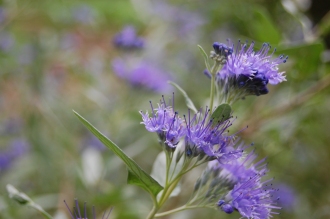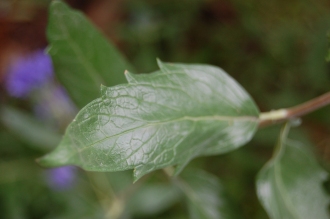Position: Full Sun
Flowering Period: Summer to Autumn
Soil: Well drained
Eventual Height: 1m
Eventual Spread: 1.5m
Hardiness: 7a, &b, 8a, 8b, 9a, 9b, 10a, 10b
Family: Lamiaceae
Caryopteris x clandonensis ‘Heavenly Blue’ is a deciduous shrub with a low mounded growth habit. The aromatic leaves of the plant are lance shaped and grey green, about 1.5 inches long. They are lightly serrated, stemmed leaves and deep green. They are paired at opposite angles and fairly widely spaced on stem. The dark blue, slightly fluffy flowers of the plant are borne in terminal and axillary clusters or cymes from late summer into autumn.
Caryopteris x clandonensis ‘Heavenly Blue’ is commonly known as Bluebeard, Blue Spirea or Blue Mist. Caryopteris × clandonensis was originally created as an accidental cross in the garden of Arthur Simmonds at West Clandon, near Guildford, Surrey in 1930 and is hybrid between two Chinese species. This plant was introduced into Britain in the 1930’s.
The etymological root of the binomial name Caryopteris is derived from the Greek meaning meaning ‘wing-nut’ in referring to the winged fruit. Clandonensis is the hybrid name given to the original cultivar in 1930 referring to it’s origins in West Clandon.
The landscape architect may find Caryopteris x clandonensis ‘Heavenly Blue’ useful as a robust drought tolerant ground cover plant. This plant is well suited to mass planting on slopes and banks. It is also effective as a low informal hedge. Once established this plant is drought tolerant. It is best grown against a south or west facing wall.
The Royal Horticultural Society has given Caryopteris x clandonensis ‘Heavenly Blue’ their it their prestigious award of Garden Merit in 2002.
Caryopteris x clandonensis ‘Heavenly Blue’ prefers any well drained soil. It will tolerate most pH of soils.
Ecologically, Caryopteris x clandonensis ‘Heavenly Blue’ is noted for attracting pollinating insects such as butterflies and honey bees.
Caryopteris x clandonensis ‘Heavenly Blue’ requires little to no maintenance. It may be trimmed in early spring to encourage flowering and a tidy habit.







